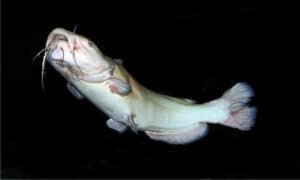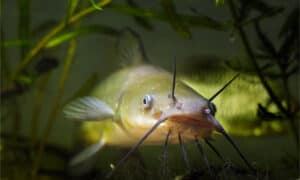Conversations surrounding rare piebald catfish usually focus on the blue catfish. This is probably due to two piebald blue catfish caught by the U.S. Army Engineer Research and Development Fish Ecology Team in 2012. Anglers with no affiliation with a government agency have also seen a few in the past, all of them blues.
However, rare piebald catfish also include channel cats and flathead cats, though they don’t seem to capture the same level of fame the blues do for unknown reasons. Blues, flatheads, and channel cats are the ‘big three’ of catfish, though many species of catfish swim in fresh, salt, and brackish waters worldwide.
Any angler will tell you that catching a piebald cat is a one-in-a-million event or even a one-in-a-billion. When it happens, there is usually a burst of local media coverage and viral social media videos. But how rare are these piebald catfish, and is it that big of a deal to catch one?
How Rare Is A Piebald Catfish?
The most imitating aspect of the question is that there is no concrete answer. It’s a straightforward question, and most of these types of queries come with a data set. Unfortunately, there is none, and the strongest indication of how rare a piebald catfish is comes from the U.S. Army Engineer Research and Development Fish Ecology Team.
Between 1997 and 2014, the team caught thousands of catfish in and around the Vicksburg, Mississippi, area. Most cats (22,230) were blues, with an additional 9,300 channel cats and 2,050 flatheads. Out of 33,580 catfish, only two were piebalds, both of which were blues.
Both of them died while in the team’s possession, one in transport and one later, following a relocation and a steady diet. Interestingly, the one that survived relocation began losing its piebald appearance as the Army research team fed it earthworms, minnows, and frozen shrimp. It died a short time later, however, after gaining much of its pigmentation back.
Outside this little experiment, there isn’t much information on rare piebald catfish, such as numbers, typical habitat, and behavior. The assumption is that they live and die much like all the other catfish, with the lack of pigmentation having no detrimental effects. The only other data on piebald catfish is the rare catch and the following brief attention.
Rare Piebald Catfish: Blue, Flathead, and Channel
The big three are the predominant catfish caught and sought after in American waters. You’ll eat one of these three if you enjoy eating catfish at a local restaurant. While most news sites and articles focus on piebald blues, the distinct lack of pigmentation isn’t intrinsic to just blue catfish.
Piebald Channel Catfish
Piebald channel cats don’t receive the same level of acclimation that blues always do. But some people catch them and choose to make it public knowledge. There are undoubtedly many anglers who have seen a once-in-a-lifetime, rare piebald channel catfish and decided to release them or eat them while taking nothing more than a personal picture.
Piebald Blue Catfish
Besides the two piebald catfish the Army caught, anglers are known for seeing them on rare occasions. Chad Hester, a Missouri angler, caught a massive piebald blue catfish in 2021. The giant, rare piebald catfish was over 40 inches in length and 36 pounds. It was not the most significant cat ever caught in the Missouri River, but it was large nonetheless. Of course, it was also a blue.
Almost ten years prior, two biologists with the Mississippi Department of Wildlife Fisheries and Parks caught a piebald blue. However, they didn’t keep it, releasing it into the river after taking its measurements. In September of 2022, Daimon Drymon, an angler in Tennessee, caught a rare piebald blue catfish in the Tennessee River.
Most of the articles on the catch reference the term ‘leucistic,’ though it’s the same as a piebald. Leucism is the term for the condition that is thought to cause piebald animals. Strangely enough, the area in the Tennessee River, where Drymon made his catch, is known for producing albino catfish at a higher rate than most places.
Piebald Flathead Catfish
Rare piebald flathead catfish get even less acclaim than channel cats. The most you can find, in terms of their existence, is on forums, where pictures are exchanged, along with the excitable chatter that comes from such a significant catch.
What Causes Piebald Catfish Patterns
A deep-dive analysis of what causes the piebald pattern in catfish is mainly absent. Biologists believe this is because it’s so tricky and rare to catch and study one that such an investigation is impossible. Most accept what we already know from the various piebald animals we’re aware of, such as piebald deer, piebald squirrels, etc.
In these animals, the piebald condition (leucism) comes from a gene mutation, likely the result of melanocytes. These melanocytes are pigment cells responsible for the various colors in most wildlife. These melanocytes are the carriers of the defective gene. This gene is known as ‘Kit’.
Kit interferes with the delivery of melanin throughout the body. We use the word ‘apparently’ because this is a theory, at least right now. Biologists assume that the same thing is happening with catfish.
Final Thoughts
Rare piebald catfish are probably no more or less occasional than piebald animals in other species. They’re all scarce, regardless of what species we’re talking about. However, when it comes to catfish, it’s not like we get a bird’s eye view of them in their natural environment whenever we choose to.
The only time anyone sees a piebald catfish is when one is caught. So, the idea of them being rarer than a piebald moose likely comes from observation capability rather than observation reality. Either way, they are extremely rare and fascinating to see. If you ever catch one or are there to see an angler reel one in, it is a once-in-a-lifetime event. Make sure to have your camera ready!
The photo featured at the top of this post is © Vladimir Wrangel/Shutterstock.com
Thank you for reading! Have some feedback for us? Contact the AZ Animals editorial team.







